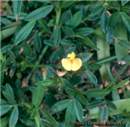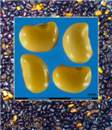Scientific name(s)
Stylosanthes guianensis var. intermedia
Strengths
- Persistent and strong coloniser on low fertility soils.
- Tolerant of heavy grazing, frost and fire because of low/buried growing points and regrows rapidly.
- Provides high quality feed when other legumes are frosted or dormant.
- Field resistance to anthracnose.
- Good palatability.
Limitations
Plant description
Plant: Perennial, low growing legume that has a well developed crown with buds above and below ground.
Stems: Fine, many branched and covered with bristles.
Leaves: Trifoliate with narrow pale to dark green leaflets usually with no hair on the upper surface but with a few hairs on the underside.
Flowers: Small and bright yellow in groups of 4 to 20.
Pods: Light brown, flattened, 1 seed per pod with a small coiled beak.
Seeds: Kidney shaped yellowish-brown, 770000 seeds (dehulled) per kg or 380000 seeds in pod/kg.
Pasture type and use
Used in native and planted perennial grass pasture.
Where it grows
Rainfall
600 to 800mm AAR.
Soils
Sands and sandy loams.
Temperature
Optimum for growth is about 30oC. Crowns of established plants have survived at -10oC.
Establishment
Companion species
Grasses: Black spear grass, Indian bluegrass, Premier digit grass.
Legumes: Round-leaf cassia
Sowing/planting rates as single species
Not usually planted as a single species in pastures. Planting rate for seed crops is 4 to 5 kg/ha of scarified seed.
Sowing/planting rates in mixtures
1 to 2 kg/ha
Sowing time
Spring and summer
Inoculation
Rhizobium strain CB 82
Fertiliser
Grows on low P soils but responds to added phosphorus.
Management
Maintenance fertliser
Not normally used.
Grazing/cutting
Regular grazing of associated grasses favours fine stem stylo and is necessary to stop grass dominance. It can be grazed heavily over summer but a short rest period in February/March helps seed production and longevity in the pasture. Continuous heavy grazing can reduce cover and allow weeds to invade and can lead to erosion.
Seed production
Seed production is high but ripening occurs over a long period and it shatters easily. Yields from mechanical harvesting range from 100 to 400 kg/ha. Suction harvesting can give higher seed yields.
Ability to spread
Produces high seed yields and is spread through surface movement ingestion and movement of livestock.
Weed potential
Very limited. In pastures it is well grazed and in disturbed areas other (larger) plants are likely to be dominant.
Major pests
No serious pests.
Major diseases
Anthracnose, little-leaf and head blight can infect fine stem stylo but are of little consequence in a grass-legume pasture.
Herbicide susceptibility
Susceptible to some broad-leaf herbicides but tolerant of 2,4-D, 2,4-DB, Basagran and Blazer.
Animal production
Feeding value
High protein forage because of its fine stem and long growing season. It can regrow rapidly after grazing and growth can extend into cooler months.
Palatability
Very palatable.
Production potential
Forage yields in pasture are generally low but can be up to 2 tonne/ha where legume density is high. Steer liveweight gain can be increased by 50 to 80 kg/head/year with high gains extending further into the cooler months than for other tropical grass-legume pastures.
Livestock disorders/toxicity
None known
Further information
Tropical Forages database (SoFT) - Fine stem stylo
Acknowledgements
-
Author and date
Bob Clem
January 2009




